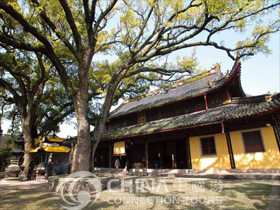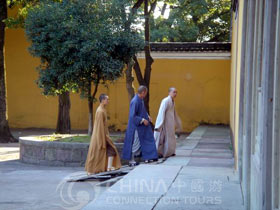 Sitting at the piedmont of Yuwang and Mount Mao, Yin County, Asoka Temple is one of the Five Mountains of Buddhism's Chan Sect (Zen) in China. As a famous temple of Chan sect of Buddhism in China, Asoka Temple has an important role in the history of Buddhism in China and in the history of Sino-Japanese cultural exchanges. Especially, the Real Body Relic of Sakyamuni, treasure of the Buddha Kingdom, enshrined in the temple. As a temple that keeps the exquisite sputa with the Sykyamuni's sarira and, the temple enjoys a very high reputation among Buddhist believers both at home and abroad.
Sitting at the piedmont of Yuwang and Mount Mao, Yin County, Asoka Temple is one of the Five Mountains of Buddhism's Chan Sect (Zen) in China. As a famous temple of Chan sect of Buddhism in China, Asoka Temple has an important role in the history of Buddhism in China and in the history of Sino-Japanese cultural exchanges. Especially, the Real Body Relic of Sakyamuni, treasure of the Buddha Kingdom, enshrined in the temple. As a temple that keeps the exquisite sputa with the Sykyamuni's sarira and, the temple enjoys a very high reputation among Buddhist believers both at home and abroad.
Formerly Asoka Temple located at the foot of Yuji Mountain, and it was built in 282 the Western Jin Dynasty (265-316), and then moved to where it stands now. After experienced several rises and declines, the existing buildings are those rebuilt after the Qing Dynasty (1644-1840). In 1980, it underwent a complete renovation. Now the whole temple occupies an area of 124,100 square meters. The existing 22,867 square meters structure area comprises more than 600 halls, towers and pavilions, which were built along the hillside. The Sputa, 1.4 meters high and 0.7 meter wide, is four cornered and five storied carved with Buddha figures on each. On the interior top hangs a Baoqing (Golden Bell) with a relic bone from the top of Sakyamuni's skull. For long, Asoka Temple has survived such natural and man-made disasters as fires in 1930 and 1958, air bombings during domestic wartime, typhoon in 1956 and devastation of the Cultural Revolution. Since 1979, with the help of special funds appropriated by the government, the Temple has assumed a new look to meet visitors from home and abroad.
 Historical records of Buddhist sources show that in the third century BC, King Asoka, who unified India, became a Buddhist and began to carry forward Buddhist doctrines. After Sakyamuni passed away, King Asoka ordered to build pagodas with the body relic (bone ash) of Sakyamuni. He ordered his people to build pagodas in any alleged Auspicious Places all over the world to place the real body relic of Sakyamuni. Totally 84,000 pagodas were built. According to the records of Buddhist scriptures, the number of such pagodas in China is nineteen. Because such temples were built by the order of King Asoka, they were named King Asoka Pagoda.
Historical records of Buddhist sources show that in the third century BC, King Asoka, who unified India, became a Buddhist and began to carry forward Buddhist doctrines. After Sakyamuni passed away, King Asoka ordered to build pagodas with the body relic (bone ash) of Sakyamuni. He ordered his people to build pagodas in any alleged Auspicious Places all over the world to place the real body relic of Sakyamuni. Totally 84,000 pagodas were built. According to the records of Buddhist scriptures, the number of such pagodas in China is nineteen. Because such temples were built by the order of King Asoka, they were named King Asoka Pagoda.

